Don't wanna be here? Send us removal request.
Text
Top AI Trends Every Business Must Know in 2025

Artificial Intelligence is no longer a futuristic concept—it's a present-day force reshaping every industry. From streamlining operations to personalizing customer experiences, AI continues to evolve at lightning speed. As we enter 2025, understanding the latest developments in AI is no longer optional; it's essential for staying competitive.
Businesses across the globe are looking at AI not just as a tool but as a strategic partner. With increasing investments and breakthroughs in areas like deep learning, natural language processing (NLP), and autonomous decision-making, AI is quickly becoming the backbone of innovation. The question is: are you prepared for what’s coming?
Among the AI trends 2025 has in store, several stand out for their disruptive potential. Technologies such as generative AI (genAI), explainable AI (XAI), and real-time data automation are leading the pack. The machine learning future points toward AI systems that not only analyze data but also generate intelligent content, simulate human reasoning, and predict market shifts with growing accuracy.
1. Generative AI Goes Mainstream
GenAI is no longer limited to tech labs and creative experiments—it’s entering boardrooms, customer service teams, and marketing departments. From generating ad copy to designing product prototypes, genAI is speeding up innovation cycles and reducing creative bottlenecks.
With models like GPT and DALL·E advancing quickly, businesses are finding new ways to reduce content creation costs, improve campaign ROI, and even automate parts of product design.
2. Hyper-Personalization with Predictive Analytics
Thanks to increasingly accurate data models, AI in 2025 enables hyper-personalized experiences in real time. Whether it's tailoring product recommendations or forecasting customer churn, predictive analytics helps companies stay one step ahead.
Retailers, financial institutions, and health tech platforms are already using AI to create customized experiences that drive conversions and build brand loyalty.
3. Responsible AI and Ethical Frameworks
As AI becomes more integrated into decision-making, ethical concerns around bias, transparency, and accountability are gaining attention. Businesses in 2025 are expected to adopt responsible AI practices—implementing audits, fairness protocols, and explainable algorithms to maintain trust and compliance.
In fact, regulatory bodies around the world are beginning to establish formal guidelines for AI deployment in sensitive sectors like finance, law, and healthcare.
4. AI in Business Operations: Beyond the Basics
AI is evolving from automating tasks to optimizing entire workflows. In sectors like logistics, HR, and manufacturing, AI helps reduce inefficiencies, optimize resource allocation, and accelerate time to market. Real-time AI monitoring systems even allow businesses to respond to issues before they become problems.
This kind of transformation requires strategic planning, but the payoff is faster execution, lower costs, and a smarter workforce.
5. New AI Use Cases Emerging Across Industries
AI is breaking into new territories—legal tech, agriculture, and even sustainability. Law firms are using AI for contract review, farms are using drones powered by AI for crop monitoring, and climate researchers are using machine learning models to predict extreme weather events.
These AI use cases reflect how adaptable and far-reaching the technology has become, proving that virtually every business model can benefit from it.
Conclusion: The Forecast Is Clear Adapt or Fall Behind
Looking at AI forecasts, it's evident that businesses that embrace innovation today will become the market leaders of tomorrow. The AI trends 2025 will bring—from real-time personalization to responsible automation—are shaping the machine learning future across every industry. The sooner your business adopts and adapts, the greater your competitive advantage.
So don’t just observe AI transformation—be part of it.
Read More:- Choosing the Best Social Media Marketing Agency in 2025
0 notes
Text
Shopify Custom Theme Development Hacks You Must Know
A professional website is essential for brand success. Learn the key factors—like mobile responsiveness, UX design, and SEO—that help businesses choose the best website design and development services.
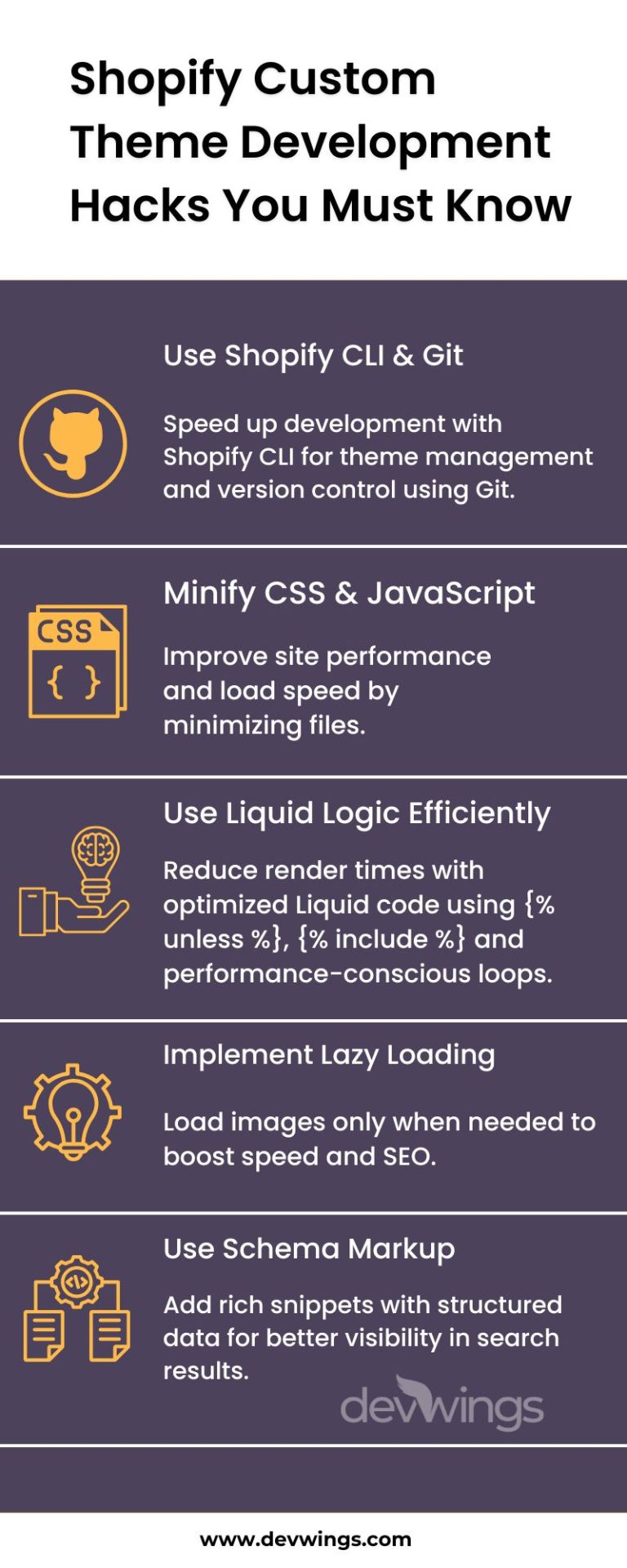
0 notes
Text
Top Website Design Trends Businesses Must Follow in 2025
The digital landscape continues to evolve at lightning speed, and businesses that fail to keep up risk falling behind. As we step into 2025, the importance of having a fresh, functional, and user-centric website has never been greater. With user expectations at an all-time high, embracing the latest web trends is essential for staying competitive and relevant.
In this blog, we explore the top website design trends shaping 2025—and why leveraging expert website design and development services is key to creating exceptional digital experiences.
1. Ultra-Personalized User Experiences
In 2025, personalization goes beyond simply greeting users by name. Modern websites are now integrating AI-powered systems to adapt content, layout, and functionality in real time based on user behavior, location, and preferences.
Whether it's displaying custom product recommendations or dynamically changing layouts for returning visitors, delivering tailored experiences boosts engagement and conversions.
Modern UI/UX principles support these hyper-personalized journeys by reducing friction and making interactions seamless.
2. Minimalism with a Purpose
Minimalist design remains a staple, but in 2025, it’s all about purposeful minimalism—stripping away clutter to highlight key content and calls to action. Clean layouts, bold typography, and focused color palettes ensure users get what they need without distraction.
Whitespace is no longer “empty space”—it’s an active design element used to guide attention and improve clarity. Website design and development services now prioritize simplicity without sacrificing functionality.
3. Dark Mode and Light/Dark Toggle
With user comfort top of mind, responsive design in 2025 includes built-in dark mode or theme toggles as a standard. Whether browsing during the day or at night, users want control over their visual experience.
Dark mode not only reduces eye strain but also saves battery life and gives websites a sleek, modern look. Expect more brands to embrace this dual-mode feature in their designs.
4. Micro-Animations and Interactive Elements
Micro-interactions—such as button animations, hover effects, and loading transitions—add personality and responsiveness to websites. These small animations provide instant feedback, improve usability, and make the experience feel more dynamic.
2025 web design focuses on using animations strategically to draw attention and increase engagement without overwhelming users. Partnering with skilled website design and development services ensures these elements enhance UX rather than hinder performance.
5. Voice-Activated Interfaces
With the rise of voice search and smart devices, voice-activated navigation is making its way into website design. Businesses that integrate voice capabilities offer users a faster, more accessible way to interact with their content.
This trend aligns with inclusive design practices, catering to users with disabilities and improving the overall accessibility of your site.
6. Mobile-First and Responsive Design Standards
Mobile traffic continues to dominate. In 2025, websites must do more than just "adapt" to smaller screens—they must prioritize mobile experiences from the start.
Responsive design is now the baseline, but mobile-first development ensures intuitive navigation, fast loading times, and seamless performance on all devices. This is not just a trend—it’s a necessity for businesses aiming to rank well and satisfy users.
7. Immersive 3D Elements and Visuals
Advancements in web technologies now allow designers to incorporate stunning 3D visuals and animations without sacrificing performance. Whether it’s a 3D product viewer, interactive background, or engaging illustrations, these immersive features enhance storytelling and keep users exploring longer.
For product-based businesses, 3D integration helps bridge the gap between physical and digital, offering a virtual showroom-like experience.
8. Sustainability-Centered Design
Eco-conscious design is becoming a priority in 2025. Websites are now optimized for energy efficiency—using lightweight code, fewer animations, and low-impact media. These “green” sites reduce carbon footprints while maintaining excellent UX.
Businesses showcasing environmental responsibility through modern UI/UX and clean, efficient design build trust and brand loyalty.
9. Scroll-Triggered Animations and Storytelling
Long scrolling pages that unfold stories as users scroll are gaining traction. This technique—known as scroll-triggered storytelling—creates immersive journeys that engage users and convey complex messages in a digestible, interactive way.
When done right, this trend combines content and design into a seamless narrative, ideal for brand pages, portfolios, and product showcases.
10. No-Code/Low-Code Platforms for Agile Development
While not strictly a visual trend, the adoption of no-code and low-code platforms is transforming how websites are built. These tools empower businesses to prototype and launch faster, reduce development costs, and make real-time updates with minimal technical support.
However, for advanced custom features and scalability, working with professional website design and development services remains crucial.
Final Thoughts
Staying ahead in the digital game means embracing the future of design today. The trends shaping 2025 emphasize personalization, accessibility, performance, and innovation. Whether it's implementing responsive design, refining modern UI/UX, or incorporating immersive visuals, businesses must adapt their websites to meet evolving user demands.
If you're ready to transform your online presence, now is the time to invest in professional website design and development services. With the right team by your side, you can craft a future-ready website that reflects your brand, engages your audience, and drives results.
0 notes
Text
How an E-Commerce Website Design Service Increases Sales
A well-structured ecommerce website design service plays a crucial role in driving sales and enhancing the customer experience. Whether you’re launching a new store or revamping an existing one, working with a web developer ecommerce expert ensures your site is optimized for conversions. This guide explores how UI/UX for e-commerce, shopping cart design, and conversion optimization contribute to business success.

1. Importance of E-Commerce Website Design
A professionally designed e-commerce site can significantly impact sales by:
Creating a seamless user experience with intuitive navigation.
Enhancing visual appeal with engaging layouts and product displays.
Improving trust and credibility with secure payment gateways.
Boosting mobile responsiveness for a better shopping experience.
2. Role of UI/UX for E-Commerce
The effectiveness of an ecommerce website design service relies on solid UI/UX for e-commerce, which includes:
Easy Navigation: Simplified menus and category structures.
Fast Loading Speed: Reducing wait times for better user engagement.
Clear Call-to-Action (CTA): Encouraging purchases with well-placed buttons.
Mobile Optimization: Ensuring smooth browsing on smartphones and tablets.
3. Optimizing Shopping Cart Design
An efficient shopping cart design can reduce cart abandonment and improve conversion rates. Key elements include:
Guest Checkout Options: Allowing users to purchase without account creation.
Progress Indicators: Showing checkout steps to enhance transparency.
Multiple Payment Methods: Providing flexibility with various payment options.
Secure Transactions: Implementing SSL certificates for customer trust.
4. Conversion Optimization Strategies
A web developer ecommerce specialist focuses on conversion optimization by:
A/B Testing: Evaluating different layouts and CTAs for performance.
Personalized Recommendations: Using AI to suggest relevant products.
Trust Signals: Displaying customer reviews and security badges.
Retargeting Campaigns: Bringing back users who abandoned their carts.
Conclusion
Investing in a professional ecommerce website design service ensures a high-performing online store that drives sales and maximizes user engagement. By optimizing UI/UX for e-commerce, shopping cart design, and conversion optimization, businesses can create a seamless shopping experience, boost customer trust, and increase revenue.
0 notes
Text
E-Commerce Growth Hacks: 5 Proven Strategies for More Sales
Supercharge your online store! 🚀 An expert e-commerce marketing agency can help you use AI personalization, social proof, and influencer marketing to drive conversions.
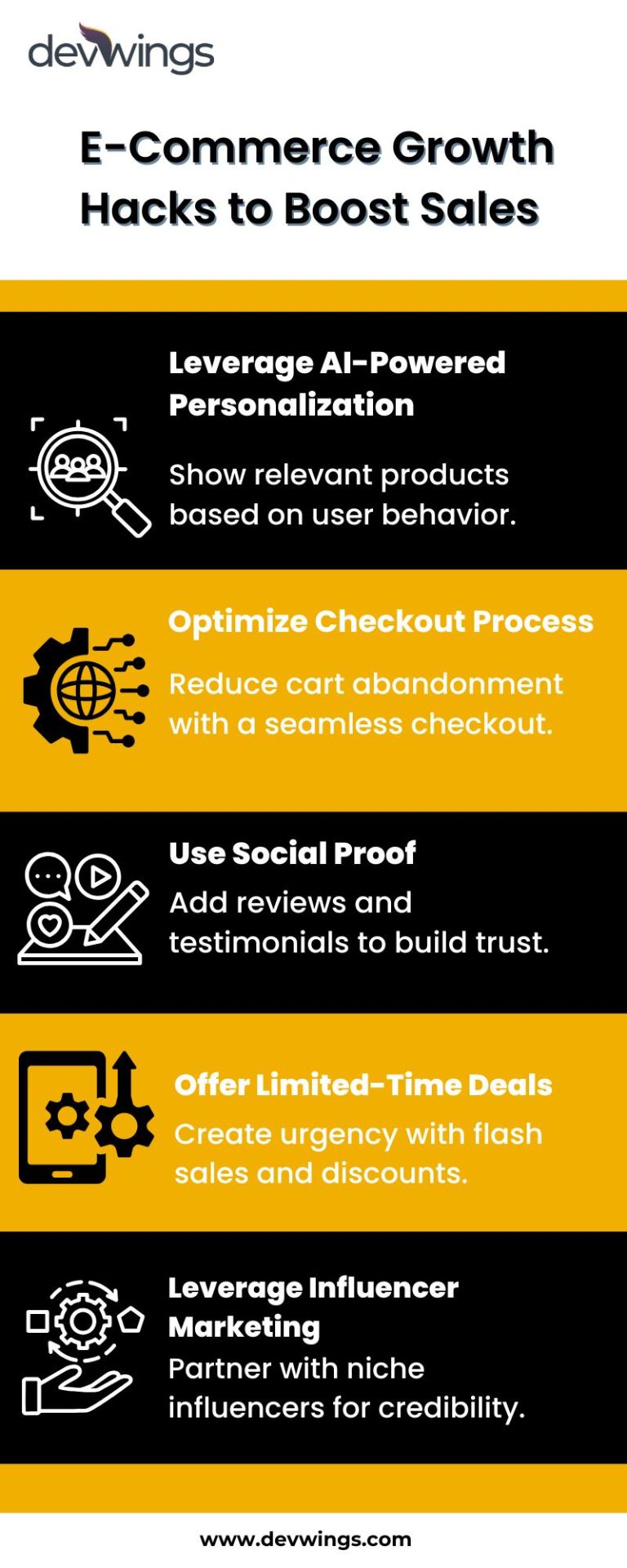
0 notes
Text
Top Website Design Trends Businesses Must Follow in 2025
In the ever-evolving digital landscape, businesses must adapt to stay ahead of the curve. This includes keeping up with the latest website design trends to ensure a positive user experience and drive engagement. Here are some of the top website design trends that businesses must follow in 2025:

Minimalist Design:
Minimalist design is characterized by its simplicity and clean aesthetic. It focuses on using only the essential elements to create a visually appealing and user-friendly website. This trend is expected to continue in 2025, with businesses opting for clean layouts, minimal text, and ample white space.
Dark Mode:
Dark mode is a design trend that inverts the colors of a website, making the background dark and the text light. This can be easier on the eyes, especially in low-light conditions, and can also help save battery life on devices. Dark mode is expected to become more prevalent in 2025, with many websites offering it as an option for users.
Voice User Interface (VUI):
Voice user interfaces (VUIs) are becoming increasingly popular, with many people using voice assistants like Siri and Alexa. In 2025, we can expect to see more websites incorporating VUIs to allow users to interact with the website using their voice. This can be especially useful for users who are visually impaired or have difficulty typing.
Artificial Intelligence (AI):
Artificial intelligence (AI) is another trend that is expected to gain traction in 2025. AI can be used to personalize the user experience, provide recommendations, and improve website performance. For example, AI can be used to personalize the content of a website based on the user's interests.
Augmented Reality (AR) and Virtual Reality (VR):
Augmented reality (AR) and virtual reality (VR) are also expected to become more prevalent in 2025. AR and VR can be used to create immersive and interactive experiences for users. For example, AR can be used to allow users to try on clothes virtually, while VR can be used to give users a virtual tour of a product or service.
Video Backgrounds:
Video backgrounds are a great way to add visual interest to a website. They can also be used to showcase products or services in a more engaging way. In 2025, we can expect to see more websites using video backgrounds, especially on landing pages and homepages.
Chatbots:
Chatbots are becoming increasingly popular as a way to provide customer support. They can be used to answer frequently asked questions, provide product recommendations, and even process orders. In 2025, we can expect to see more websites incorporating chatbots into their design.
Micro-interactions:
Micro-interactions are small animations or transitions that provide visual feedback to users. They can be used to make a website more engaging and interactive. In 2025, we can expect to see more websites using micro-interactions to create a more enjoyable user experience.
Accessible Design:
Accessible design is becoming increasingly important, as more and more people with disabilities are using the internet. In 2025, we can expect to see more websites incorporating accessible design principles, such as using alt text for images and providing keyboard navigation.
Personalized Experiences:
Personalization is another trend that is expected to continue in 2025. Websites can use data to personalize the user experience, such as by recommending products or services based on the user's interests.
By following these website design trends, businesses can create websites that are engaging, user-friendly, and effective.
0 notes
Text
Boost Your Campaigns with These 5 Top Email Marketing Tools
Want higher email engagement? Discover the top 5 email marketing tools trusted by successful brands to increase conversions & customer loyalty! 🚀
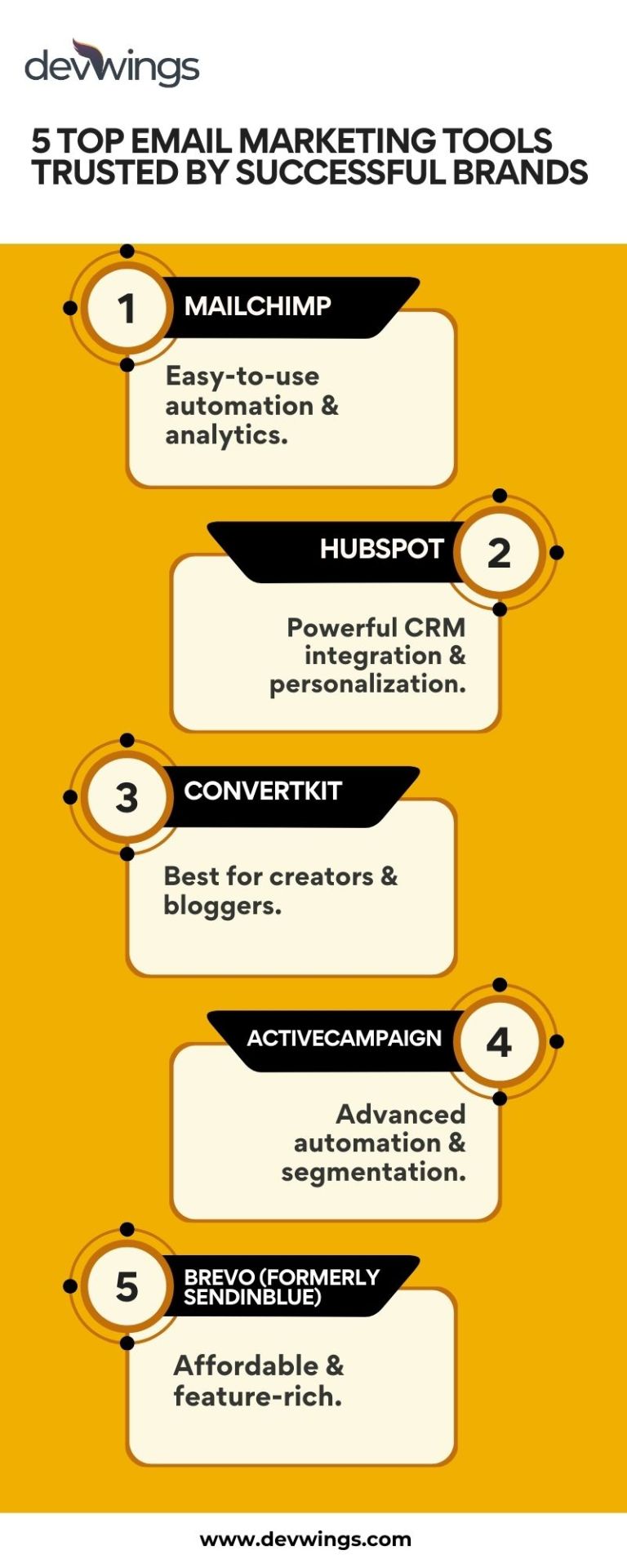
0 notes
Text
Boost Your Local SEO Rankings with These Proven Strategies!
Want more local customers? Follow these expert Local SEO services tips to rank higher and drive traffic! 🚀📍
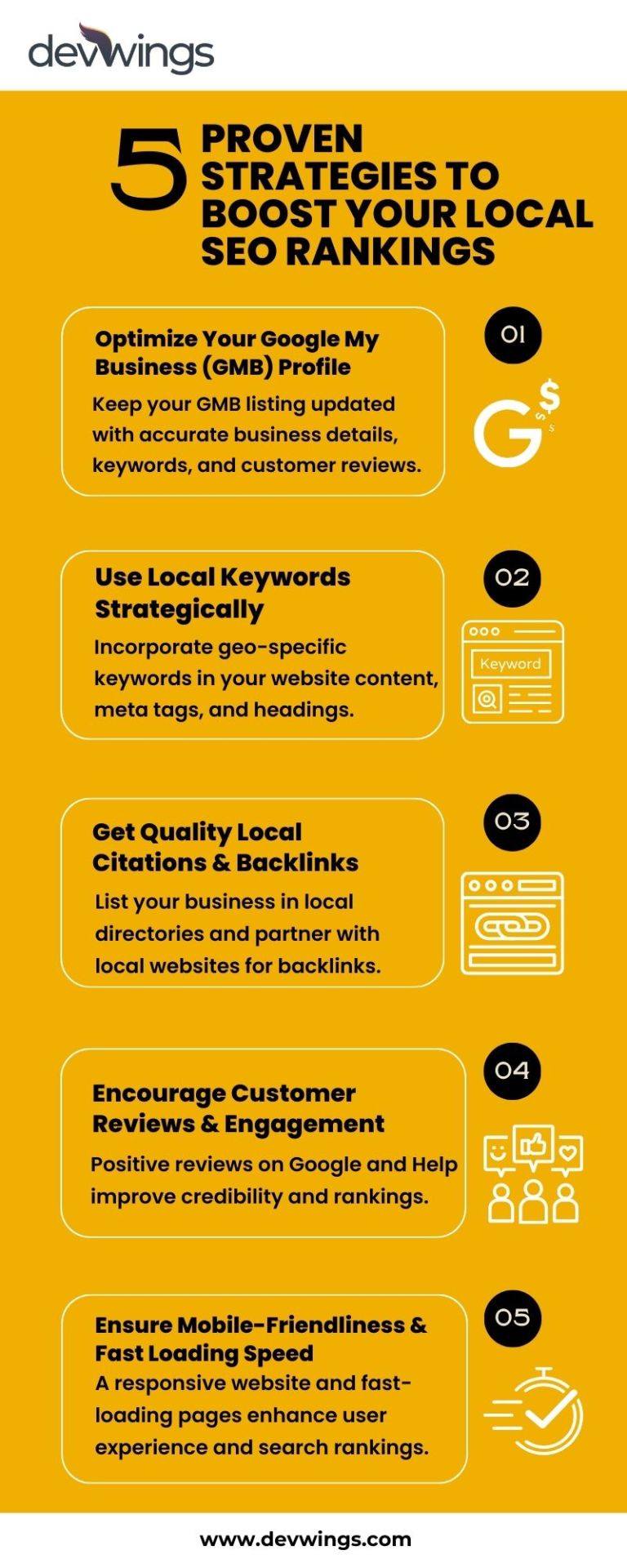
0 notes
Text
Why Custom Web Development Is a Game-Changer for Small Businesses?
In today’s hyper-competitive digital landscape, every business—regardless of size—needs a strong and impactful online presence. For small businesses, this is especially critical, as their website is often their first touchpoint with potential customers. While website builders and templates may seem like a quick fix, custom web development has come as the ultimate tool for driving small business growth. By collaborating with a professional web development company, small businesses can craft tailor-made web solutions that deliver unique value, establish credibility, and stand out in crowded markets.

What is Custom web development?
Custom web development refers to the development of a website from the scratch for your organization. Custom websites are unique products that are developed from the ground up to meet your objectives, your target market, and your image. Such a strategy helps to guarantee that every aspect of your site is in synergy to meet your goals.
For small businesses, this implies having a website that has the right branding, addresses the needs of the customers, and has the right features that will enable the business to expand in its chosen field. It is an unfortunate misconception to think of a custom website as a mere online storefront; it’s so much more than that.
Why is customization better than templates?
a. Unique Design and Branding
Your business is unique, and your website should be the same, so why are you just like all the rest? Custom web development lets you create a website that is designed to your brand, its ideals, and its goals. With custom design, you can:
Design a stunning website or application that will make your audience connect with you.
Add design features that are specific to your business.
Distinguish oneself from the competitors based on the templated designs.
b. Flexibility and Scalability
Website needs of your small business will gradually increase as your business expands. When using a template, many opportunities to extend the functionality of the site in response to new needs, such as the addition of e-commerce capabilities, integration with CRM systems, or analysis tools, may be missed. Custom web development means that your site can grow with your business because all the web components are designed for your company’s needs.
c. Enhanced Functionality
Custom-built websites allow businesses to integrate advanced features like:
Innovative product demonstrations.
Customer specific interfaces for a summary of their related services.
Specific shapes and automatic procedures.
Some of these functionalities enhance the usage experience and at the same time increase customer loyalty.
The Role of Custom Web Development in Small Business Growth
a. Optimized for Performance
Speed and performance are among the crucial success factors online. A survey has revealed that a website with more than 3 seconds loading time will make its users leave. The customized website is devoid of extra code, thus optimized to be very fast, meaning that your audience stays.
A faster site also means better SEO rankings, which gets you appearing higher in search results. That translates into more traffic, more leads, and ultimately more sales [1].
b. Tailored User Experience (UX)
The user experience of a website is what can make or break customer interactions. Custom development enables:
Streamlined navigation
Intuitive interfaces
Mobile-first designs.
These will provide a seamless experience when on a desktop or on their smartphone. A good UX means more engagement and more conversion.
c. Creates Trust and Credibility
Online first impressions are everything. It presents to customers that you can be trusted and your company is credible. Your company represents your brand, and having a clean platform lets everyone know you are serious about business as well as your customers.
Boosting Online Presence with Custom Web Development
Your website is not a static platform; it is the base of your online presence. Custom development gives you the tools to:
a. Optimize for SEO
Search engines reward websites that are fast, user-friendly, and content-rich. A custom-built site allows you to incorporate SEO best practices from the ground up, such as:
Structuring code for better crawlability.
Creating responsive designs for mobile SEO.
Adding schema markup for rich search results.
These optimizations increase your visibility in search results, driving organic traffic to your site.
b. Integrate Marketing Tools
A custom website can seamlessly integrate with marketing tools like:
Google Analytics for tracking visitor behavior.
Email marketing platforms for lead nurturing.
Social media integrations to boost engagement.
By combining these tools, your website becomes a central hub for all your marketing efforts.
c. Leverage Local SEO
A custom site can make a small business that targets local customers more visible in local search results. Some of the features that make this happen include location-based keywords, integrated Google Maps, and customer reviews.
Custom Web Development vs. Cost-Effective Templates
While templates may seem appealing for their affordability and speed, they come with significant limitations:
Limited Customization: Templates restrict your ability to make significant changes, leaving you with a cookie-cutter website.
Generic Features: Most templates come with pre-loaded features you may never use, making your site slower and less efficient.
SEO Challenges: Template-based sites often lack proper SEO optimization, making it harder to rank in search engines.
Scalability Issues: When your business grows, templates can become a hindrance, requiring costly migrations to custom solutions.
In contrast, custom web development offers long-term value, ensuring your website remains relevant, functional, and impactful.
Future-Proofing Your Business
In a rapidly changing digital world, adaptability is key. Custom web development gives small businesses the flexibility to:
Integrate emerging technologies like AI chatbots and virtual shopping assistants.
Update designs to match evolving trends.
Expand functionalities as market demands change.
This adaptability ensures that your website stays ahead of the curve, keeping your business competitive and ready for future challenges.
How to Get Started with Custom Web Development?
If you’re ready to invest in a custom website, here’s how to get started:
Partner with a Web Development CompanyChoose a team with experience in creating custom solutions for small businesses. Look for developers who understand your industry and can deliver results tailored to your goals.
Define Your ObjectivesClearly outline what you want to achieve with your website. Whether it’s generating leads, selling products, or building brand awareness, having a clear roadmap ensures the development process stays on track.
Focus on User ExperienceWork with your developers to prioritize user experience in every aspect of the site, from navigation to content layout.
Invest in SEO and AnalyticsEnsure your website is optimized for search engines and equipped with analytics tools to track performance.
Plan for MaintenanceCustom websites require ongoing maintenance to ensure they remain functional, secure, and up-to-date. Partner with your development company for regular updates and support.
Conclusion
For small businesses hoping to thrive in today's digital-first world, custom web development is a game-changer. It is an investment in your brand, in your growth, and in your future. Unlike other templated solutions, customized web solutions provide unparalleled flexibility, performance, and scalability to ensure your business stays ahead of the competition.
Partnering with a professional web development company gives one the tools and expertise of creating a website that not only meets today's needs but also puts you in a ready position for tomorrow. Regardless of whether you are stepping into business or elevating your online presence, that is exactly what custom web development unlocks for your business's full potential.
Read More:- How to Future-Proof Your Website for 2025 Trends
0 notes
Text
Optimizing Paid Ads: Advanced Strategies for 2025
Stay ahead with AI-driven bidding, hyper-personalization, interactive ads, omnichannel retargeting, voice search optimization, and Google Local Services Ads to maximize paid ad performance in 2025.
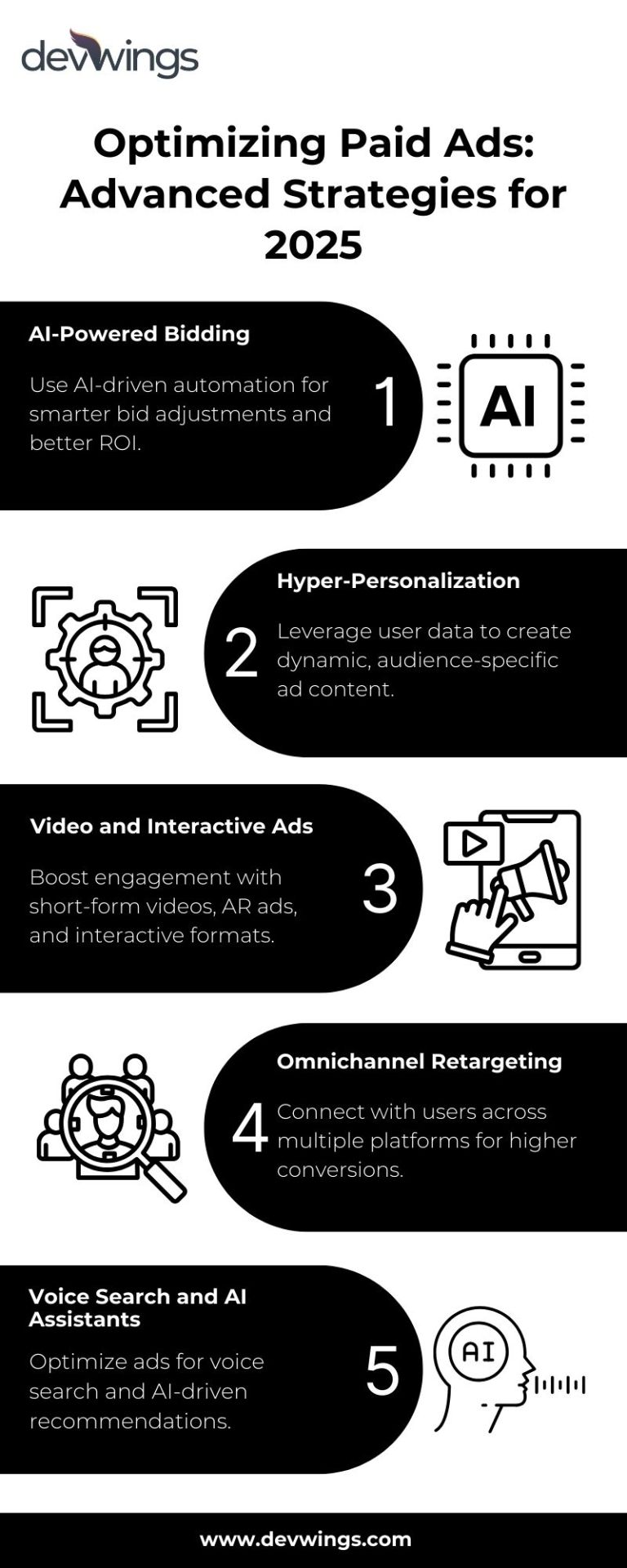
0 notes
Text
How Google My Business Drives Hyperlocal SEO
In the ever-evolving digital landscape, businesses must adapt to ensure they stand out in their local markets. One of the most powerful tools for achieving this is Google My Business (GMB). Optimizing your GMB profile plays a crucial role in enhancing location-based SEO efforts, especially for businesses that rely on attracting customers from a specific geographic area. This blog will delve into how Google My Business drives hyperlocal SEO and why it's essential for businesses to harness its full potential.

What is Hyperlocal SEO?
Before diving into the specifics of GMB, it’s essential to understand what hyperlocal SEO entails. Hyperlocal SEO is a subset of location-based SEO, where businesses focus on optimizing their digital presence to attract customers from a very specific area. This can include a neighborhood, district, or even a particular street. Hyperlocal SEO is highly relevant for service-based businesses such as cafes, salons, repair services, and local retailers that depend on foot traffic or local customers.
In a world where consumers are increasingly searching for “near me” solutions, hyperlocal SEO ensures that your business is seen by the right audience at the right time. When implemented effectively, Google Local Service and GMB optimization can help drive this localized search traffic directly to your business.
The Role of Google My Business in Hyperlocal SEO
Google My Business is a free tool that enables businesses to manage their online presence across Google, including Search and Maps. For local businesses, GMB is a game-changer as it allows them to directly engage with potential customers who are searching for their services or products.
Here’s how GMB plays a pivotal role in hyperlocal SEO:
Improved Local Visibility When properly optimized, your GMB listing appears in Google Search results, often in the coveted “local pack” — a boxed section that showcases three local businesses related to a user’s search query. These listings include essential details such as business name, address, phone number, website link, and customer reviews, making it easier for users to engage with you. This visibility is crucial for businesses looking to attract local customers.
Relevance to Location-Based Searches One of the key benefits of GMB optimization is that it helps search engines understand where your business is located, allowing it to rank higher for location-based searches. When a person searches for services near them, Google uses the information from GMB to determine which businesses are closest to the user. With accurate and up-to-date location data, your business can rank better for geo-targeted search queries like “best plumber in [neighborhood]” or “restaurants near me.”
Customer Reviews and Engagement Google My Business allows customers to leave reviews directly on your listing, which not only builds trust but also boosts your local SEO rankings. Positive reviews signal to Google that your business is trustworthy and relevant, which helps improve your search visibility. Furthermore, responding to customer reviews shows that your business is engaged, encouraging potential customers to make a decision.
Accurate and Consistent Business Information Having consistent NAP (Name, Address, Phone Number) information across the web is crucial for location-based SEO. GMB allows you to manage and update this information regularly, ensuring that customers can find you easily online and offline. When your business information is accurate, it increases the chances of being ranked higher in local search results, and it also helps build customer trust.
Enhanced Customer Experience GMB offers features such as the ability to post updates, share events, and upload photos or videos of your products or services. These updates not only keep your customers informed but also give your business a dynamic presence on Google. These features directly impact hyperlocal SEO by improving user engagement and satisfaction, factors that Google considers when determining search rankings.
Best Practices for GMB Optimization to Drive Hyperlocal SEO
Optimizing your Google My Business listing is key to driving hyperlocal SEO. Here are some actionable steps to ensure you’re getting the most out of your GMB profile:
Complete Your GMB Profile The more information you provide, the better. Fill out every section of your GMB profile, including business hours, contact details, website, services offered, and business description. A complete profile builds trust and ensures Google can accurately display your business to relevant users.
Add High-Quality Photos Photos play a significant role in customer decision-making. Businesses with photos receive 42% more requests for directions and 35% more click-throughs to their websites. Include high-quality images of your storefront, products, services, and staff to give potential customers a feel for what your business is about.
Encourage Reviews and Respond to Them Customer reviews are a powerful factor in local rankings. Encourage satisfied customers to leave positive feedback on your GMB listing, and always respond to reviews (both positive and negative) in a timely and professional manner. Engaging with customers shows you value their feedback, which can strengthen your local SEO.
Post Regularly GMB allows businesses to post updates, offers, events, and announcements. Regular posts keep your listing fresh and show Google that your business is active. Posting frequently can improve your search visibility, especially when targeting local audiences who may be searching for timely information or offers.
Utilize GMB Insights GMB Insights provides valuable data about how customers are interacting with your listing, such as how they found your business and what actions they took. Analyzing these insights helps you understand your customer base and refine your location-based SEO strategy to better target local search queries.
The Impact of Google Local Service Ads (LSA)
Google Local Service Ads (LSAs) are another tool to enhance hyperlocal SEO. These ads appear above the traditional Google search results, making them highly visible to users. LSAs are perfect for service-based businesses such as locksmiths, electricians, and home cleaning services, as they show up when users search for specific services in their area.
By running LSAs, businesses can gain additional visibility for their services in targeted geographic areas, boosting both their GMB performance and overall location-based SEO strategy.
Conclusion
Google My Business is a cornerstone of hyperlocal SEO. By optimizing your GMB profile, businesses can enhance their visibility in local search results, engage with customers, and ultimately drive more traffic to their physical locations. The combination of GMB optimization, Google Local Service, and a consistent SEO strategy can make a significant impact on your local rankings. As a business owner, it’s crucial to continuously monitor and optimize your GMB profile to stay ahead of the competition and ensure that your business is easily discoverable by local customers. With GMB, driving hyperlocal SEO has never been more accessible or effective.
0 notes
Text
15 PPC Trends You Can’t Ignore in 2024 and 2025
Pay-per-click (PPC) advertising has long been a cornerstone of digital marketing strategies. However, the PPC landscape is evolving rapidly, driven by advancements in technology, changes in consumer behavior, and the increasing competition for online visibility. For businesses to remain competitive, it’s vital to stay ahead of emerging trends.

In this blog, we’ll explore 15 PPC trends shaping 2024 and 2025 that every business and PPC advertising agency should pay attention to. From automation to audience targeting, these trends are set to redefine how advertisers craft their PPC strategies.
1. Automation Takes Center Stage
Automation is becoming integral to PPC campaigns. Tools like Google Ads Smart Bidding use machine learning to optimize bids in real time, ensuring better results with less manual intervention.
Why it matters:
Saves time by reducing the need for constant campaign monitoring.
Ensures better performance by analyzing vast datasets quickly.
2. First-Party Data Becomes Essential
With third-party cookies being phased out, first-party data is gaining prominence. Businesses must now focus on collecting and leveraging customer data through CRM systems, email lists, and user behavior analytics.
Key advantages:
Personalized ad experiences.
Improved audience segmentation for precise targeting.
3. Voice Search Integration
The growing popularity of voice search is changing how people find information. PPC campaigns need to incorporate conversational keywords and questions to target voice-driven queries effectively.
How to adapt:
Use long-tail keywords aligned with natural speech patterns.
Create ad copy that mirrors voice search behavior.
4. Rise of Video Ads
Video content continues to dominate the digital landscape, and PPC is no exception. Platforms like YouTube and TikTok are excellent avenues for video ads, offering high engagement rates.
Strategies for success:
Use compelling visuals to grab attention within the first few seconds.
Optimize videos for mobile viewing.
5. AI-Powered PPC Strategies
Artificial Intelligence (AI) is revolutionizing PPC by analyzing trends, predicting outcomes, and improving ad placement accuracy. AI tools can even generate ad copy and visuals based on data insights.
Benefits of AI in PPC:
Enhanced targeting precision.
Continuous campaign optimization based on real-time feedback.
6. Local PPC Targeting Gains Momentum
With users increasingly seeking products and services nearby, local PPC targeting is on the rise. Features like location extensions in Google Ads can boost your visibility among local audiences.
How to maximize local PPC impact:
Include location-based keywords.
Optimize for mobile users searching on the go.
7. Interactive Ads Engage More Users
Interactive ads, such as surveys, quizzes, and AR filters, are capturing audiences’ attention. These ads create memorable experiences that increase brand recall and engagement.
Why it’s effective:
Encourages direct interaction with the audience.
Increases time spent engaging with the ad content.
8. Focus on Privacy-First Advertising
As privacy regulations tighten, advertisers must adopt privacy-first practices. Transparent data usage and compliance with laws like GDPR are non-negotiable.
Steps to ensure compliance:
Use consent-based data collection methods.
Communicate how user data is utilized.
9. Omnichannel PPC Campaigns Dominate
Consumers interact with brands across multiple platforms, from social media to search engines. Omnichannel PPC strategies ensure a consistent message across all touchpoints.
Tips for omnichannel success:
Synchronize ad creatives and messaging across platforms.
Track user behavior to deliver cohesive experiences.
10. Programmatic Advertising Expands
Programmatic advertising automates the buying of digital ads, delivering personalized experiences at scale. With programmatic platforms evolving, this trend is set to gain more traction.
What to watch for:
Adoption of AI-driven programmatic ad tools.
Expansion into emerging platforms like connected TV.
11. Shoppable Ads Reshape E-Commerce
Shoppable ads simplify the customer journey by allowing users to purchase directly from the ad itself. Platforms like Instagram and Pinterest are leading the charge in this area.
How to use shoppable ads effectively:
Showcase high-quality images of your products.
Include clear calls to action to guide users.
12. Microtargeting for Niche Audiences
PPC strategies are moving towards hyper-specific targeting to reach niche audiences. By focusing on granular segments, brands can increase relevance and engagement.
Examples of microtargeting:
Using behavioral data to target users with specific interests.
Leveraging geofencing to attract customers within a defined radius.
13. Enhanced Audience Retargeting
Retargeting remains a powerful PPC tactic, and advancements in tracking technologies are making it even more effective. Dynamic retargeting, for instance, allows personalized ads based on users’ previous interactions.
Best practices:
Use retargeting to re-engage cart abandoners.
Create custom audiences based on website activity.
14. Smart Shopping Campaigns Grow
Google Ads’ Smart Shopping campaigns use automation to manage ad placement and bidding. These campaigns are particularly effective for e-commerce businesses looking to maximize ROI.
Advantages of Smart Shopping:
Simplified campaign management.
Seamless integration with Google’s retail network.
15. Sustainability in PPC Advertising
Consumers are increasingly prioritizing sustainability when choosing brands. PPC campaigns that highlight eco-friendly initiatives can attract environmentally conscious users.
How to incorporate sustainability:
Use ad copy that emphasizes green practices.
Partner with influencers advocating sustainability.
Conclusion
The PPC landscape in 2024 and 2025 is dynamic, offering immense opportunities for businesses that adapt quickly. By staying ahead of these trends, you can craft innovative and effective campaigns that drive results.
At Devwings, we understand the complexities of the evolving PPC ecosystem. Our data-driven approach helps businesses harness emerging trends to stay competitive and achieve their advertising goals efficiently.
0 notes
Text
Web Development vs. App Development: Which is Best for You?
Explore the key differences between web development and app development to determine the best approach for your business needs and goals with expert website design and development services!
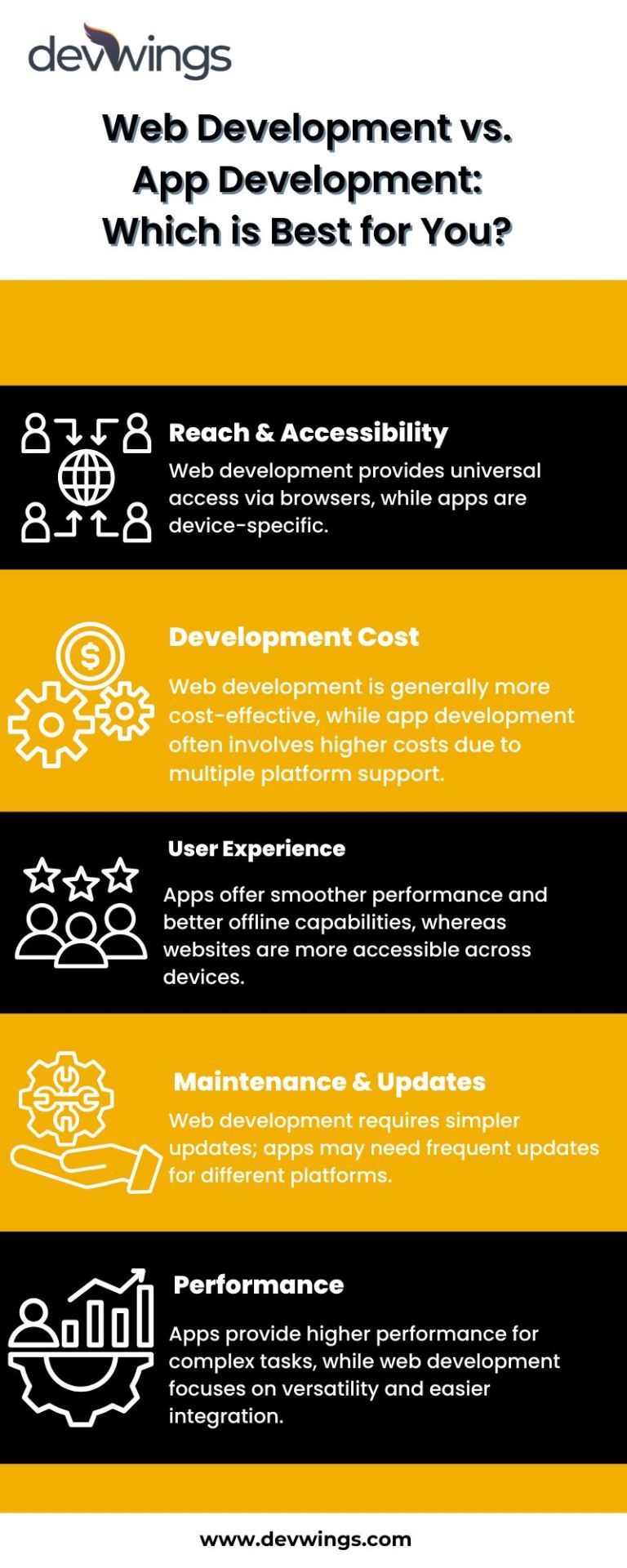
0 notes
Text
Why Responsive Web Design is Crucial for Your Business
In today's fast-paced digital world, having an adaptable website has become crucial. Since mobile devices are the main way that people access the internet, businesses need to make sure that users enjoy a seamless experience on all devices.

This is where responsive web design—a blend of usability, accessibility, and aesthetics—comes into play. Any kind of company can benefit greatly from working with a reliable web development company.
This blog explores the value of adaptable web design for modern businesses and how it affects user experience and search engine results.
What does responsive web design entail?
RWD, or responsive web design, enables your website to adapt its appearance and features according to the device being used. The design is still readable and functional whether viewed on a smartphone, tablet, or desktop computer. The goal is to make the user experience consistent across screen sizes.
Why Responsive Design Is Important
1. The The majority of Mobile in Internet Traffic
Currently, more than half of all web traffic comes from mobile devices. Companies that disregard mobile-friendly designs run the danger of losing a sizable percentage of their clientele. Websites can be tailored to meet the needs of contemporary consumers when a mobile-first strategy is used.
2. A better experience for users
Because responsive websites are easy to use and load quickly, browsing them is more fun. Higher bounce rates are frequently the result of poor design or challenging navigation since users will frequently leave websites that irritate them.
3. Improved SEO Results
Websites that are optimized for mobile devices are ranked higher by Google. By adhering to Google's mobile-first indexing policy, a responsive design makes your website more visible in search results. More traffic and improved rankings could come from this.
4. Economicalness
Separate desktop and mobile websites are no longer necessary thanks to responsive web design. In addition to saving money, maintaining a single website also requires less work in terms of development and maintenance.
5. Preparing for the Future
Responsive web design guarantees that your website will continue to work on new devices as technology advances. Your company won't need to revamp as often thanks to this flexibility.
Benefits of Responsive Design for Businesses
A responsive website provides several competitive advantages:
Builds Trust with Users: A professional, well-optimized site makes a lasting impression on visitors. Customers are more likely to trust and engage with a business that provides an effortless online experience.
Increases Conversions: By lowering barriers to use, businesses can increase conversion rates. Customers are more likely to act when a process is smooth, whether that action is filling out a form or making a purchase.
Simplifies Analytics and Reporting: By utilizing a single responsive website, businesses can more efficiently monitor and evaluate performance and gain crucial insights into user behavior.
Gains a Competitive Edge: A responsive website shows prospective customers that your company prioritizes accessibility and innovation in a cutthroat environment.
Responsive Design vs. Traditional Web Design
Traditional web design often involves creating separate versions for mobile and desktop users, which can be costly and inefficient. On the other hand, responsive web design makes sure that a single website works flawlessly on all kinds of screens. While responsive designs put consistency and usability first, traditional websites may look broken or be challenging to use on smaller displays. This distinction affects everything, including long-term maintenance expenses and user experience.
How to Implement Responsive Web Design
1. Adopt a Mobile-First Approach
Design your website for smaller screens first, then scale up for larger devices. This ensures that essential features are accessible on all platforms.
2. Make use of fluid layouts
Your content will appear fantastic on any screen size thanks to flexible grids and layouts that enable your website to scale automatically.
3. Maximize Media
In order to guarantee quick loading times without compromising quality, employ responsive media queries and compress pictures.
4. Extensive Testing
Test your website on a variety of hardware and browser combinations to find and fix performance issues.
5. Give Page Speed Priority Slow-loading websites turn off visitors. Optimize loading times by using caching technology and removing unnecessary items.
Problems with Responsive Web Design
It takes skill and accuracy to create responsive websites. Keeping loading times quick, making sure complex navigation functions on several devices, and dealing with browser compatibility are common problems. Working with a skilled web development company that is aware of the nuances of responsive design is crucial because of these difficulties.
The Function of a Website Development Firm
Implementing responsive web design requires the assistance of a seasoned web development company. They guarantee that your website satisfies contemporary standards for usability, accessibility, and aesthetics from the very beginning to the very end. By utilizing their knowledge, companies may concentrate on expansion while letting the professionals handle the technical aspects.
Real-Life Success Stories of Responsive Design
Numerous businesses have thrived due to responsive web design.
E-commerce Brands: Leading online stores like Amazon and eBay provide flawless experiences across devices, resulting in high customer satisfaction and increased sales.
Education platforms: To provide easily accessible learning materials on all platforms, websites such as Coursera leverage responsive design.
Startups: By using responsive web design, smaller businesses can show their professionalism and dedication to accessibility.
How Devwings Can Help
Our team works hard to create designs that improve engagement, promote progress, and are device-neutral. We guarantee a fantastic user experience on your website while maintaining mobile-first optimization by utilizing the newest technologies.
Collaborate with Devwings to make your company future-proof and distinctive in the current digital environment.
0 notes
Text
5 Effective Link Building Strategies That Always Deliver Results
Boost your SEO with these proven link building strategies guest blogging, content creation, broken link building, influencer outreach, and the skyscraper technique. These methods consistently deliver results in digital marketing!
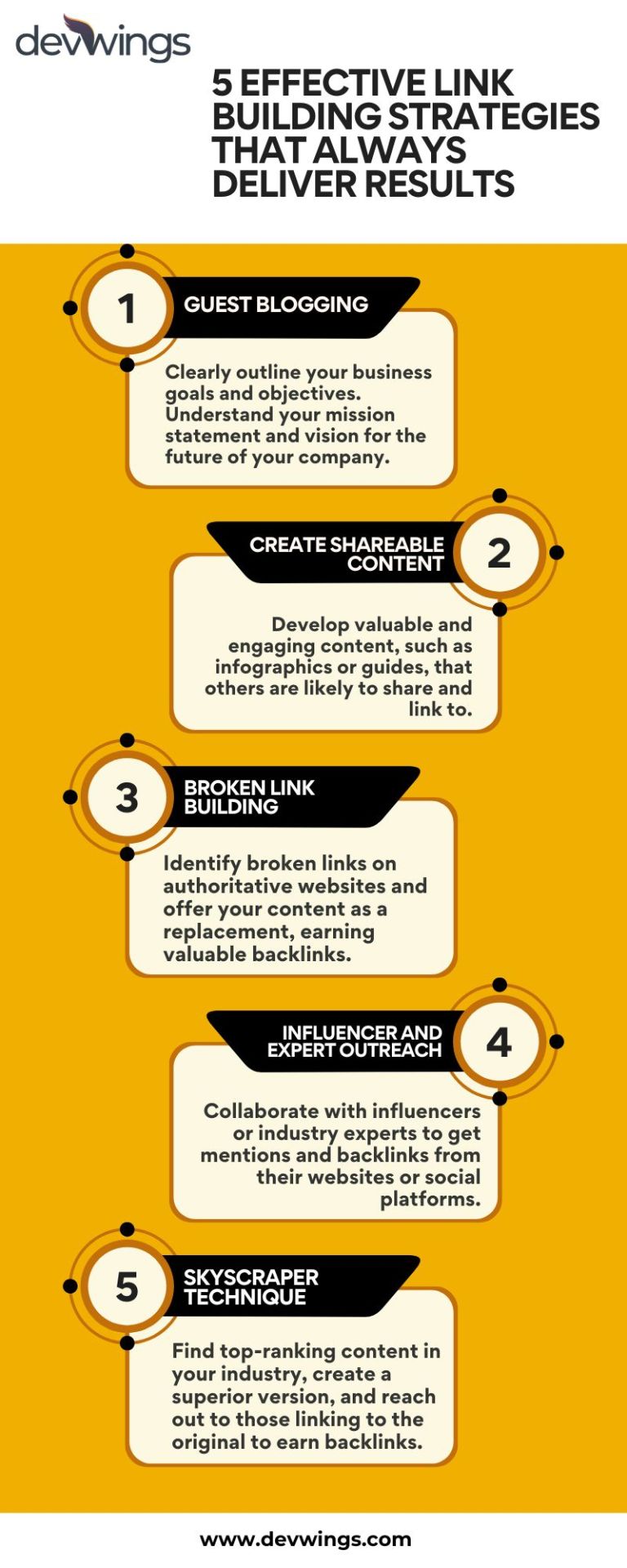
0 notes
Text
10 SEO Trends to Watch in 2024 for Better Visibility
In the ever-evolving world of search engine optimization (SEO), staying on top of the latest SEO trends is key for businesses looking to gain an edge.
With search engines like Google updating their algorithms and user expectations rising, understanding which strategies will impact digital visibility can make a big difference for companies aiming to capture online audiences.

A professional SEO optimization agency plays a crucial role in helping brands navigate these changes and implement cutting-edge strategies for growth.
Below, we’ll dive into the top 10 SEO trends to keep an eye on in 2024 and how they influence ranking factors and visibility.
1. Enhanced AI in Search Engine Algorithms
Artificial intelligence (AI) has rapidly changed how search engines understand and deliver results. In 2024, we’ll see AI playing an even larger role, improving how search engines interpret user intent and context. Advanced algorithms like Google’s RankBrain and BERT are refining search results by analyzing digital visibility through semantic connections and relevance rather than just keywords.
Key Takeaway: Creating content that matches user intent and offers real value will be crucial for improving rankings, and SEO optimization agencies will focus on aligning content with AI-driven search behavior.
2. Emphasis on E-E-A-T Content
Google has elevated the importance of Experience, Expertise, Authoritativeness, and Trustworthiness (E-E-A-T) in content evaluation. High-quality, expert content from reliable sources is rewarded with better rankings, especially in areas like finance, healthcare, and law. This trend underscores the need for authoritative content creation strategies to meet ranking factors effectively.
Key Takeaway: Working with subject-matter experts and building reputable content will be pivotal in 2024.
3. Voice Search Optimization
With the popularity of smart speakers and voice-activated devices, voice search has emerged as a key trend. Users ask conversational questions, often searching with longer, more natural queries. An SEO optimization agency can help companies refine their content for voice search to enhance their chances of appearing in voice search results.
Key Takeaway: Incorporate natural language and long-tail keywords into your content to stay competitive in the voice search landscape.
4. Mobile-First Indexing
As mobile usage outpaces desktop, Google has increasingly shifted to mobile-first indexing, meaning a site’s mobile version is prioritized when determining rankings. Optimizing for mobile is essential not only for digital visibility but also for ensuring a smooth user experience.
Key Takeaway: Ensuring a mobile-friendly design, faster loading times, and smooth navigation will help improve mobile rankings and engagement.
5. Rise of Video Content and SEO
Video content continues to grow in importance. Platforms like YouTube and even Google prioritize video in search results, making it an effective tool for engagement and SEO. Video can boost time on page, a key metric that signals quality to search engines.
Key Takeaway: Incorporate video into your strategy to improve user engagement and digital visibility while addressing SEO trends like multimedia content optimization.
6. Structured Data and Schema Markup
Structured data and schema markup help search engines understand the content of a page, providing a clear framework for better indexing. They enable rich snippets that can improve click-through rates and enhance visibility in SERPs.
Key Takeaway: Implementing schema markup for articles, FAQs, product pages, and reviews can help create more informative search results, ultimately impacting ranking factors.
7. Optimizing for Local Search
With increased mobile usage, local search optimization remains a top priority for businesses with physical locations. Google My Business profiles, local keywords, and localized content help businesses improve digital visibility and attract nearby customers.
Key Takeaway: Emphasize local SEO tactics such as accurate location data, customer reviews, and local content to stay competitive in the local market.
8. Core Web Vitals as a Ranking Factor
Core Web Vitals, which include loading speed, interactivity, and visual stability, are performance metrics that significantly affect ranking factors. These metrics influence user experience and site rankings, making it important to optimize them.
Key Takeaway: Working with a skilled SEO optimization agency can help businesses achieve Core Web Vitals benchmarks, ultimately leading to improved digital visibility.
9. Content Refreshes for SEO Boost
Updating and republishing older content is a quick and effective way to enhance rankings. Content refreshes allow websites to stay relevant, meet current user needs, and align with the latest SEO trends without always having to create new content.
Key Takeaway: Regularly audit and update content to improve relevance and rankings, focusing on adding value, updating data, and incorporating new insights.
10. Privacy and Data Security as User Priorities
In an era of data privacy concerns, search engines favor sites that handle user data responsibly. Websites that prioritize transparency in data handling and respect for user privacy are likely to see benefits in digital visibility.
Key Takeaway: Incorporating data protection measures and clear privacy policies not only fosters user trust but also aligns with current SEO trends that prioritize user safety and trust.
Embracing SEO Trends with the Right Strategy
The SEO landscape is changing fast, and keeping up with these trends can be challenging. By partnering with a reputable SEO optimization agency, businesses can ensure they are implementing the most effective strategies for 2024. Staying proactive, adapting to ranking factors, and focusing on delivering valuable content will position brands for growth.
At Devwings, we understand the intricacies of SEO trends and are committed to driving digital visibility through optimized, user-centered content.
#digital marketing services#devwings#jaipur#rajasthan#SEO Trends#seo optimization agency#SEO Agency#Digital Marketing Company
0 notes
Text
6 Critical PPC Ad Mistakes That Can Destroy Your Conversion Rates
In the fast-paced digital marketing world, PPC advertising provides a powerful way to reach potential customers quickly. But running a successful PPC campaign is about more than just getting clicks; it's about driving conversions.
Making mistakes in your PPC campaigns can lead to wasted ad spend and missed revenue.
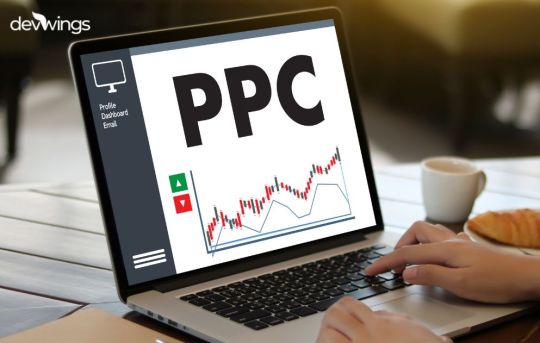
An Advertising Agency helps avoid these pitfalls, ensuring that your campaign drives real results.
Here, we’ll break down six common PPC ad mistakes and how to steer clear of them to boost conversion rates.
1. Targeting the Wrong Audience
Effective audience targeting is the backbone of any PPC campaign. One of the most frequent errors is casting too wide a net to capture a larger audience, which often dilutes the effectiveness of the message. Alternatively, overly narrow targeting can result in missing valuable customers.
Solution: Start by defining your ideal customer demographics and behaviors. Utilize platform insights to continually refine your audience and leverage a PPC Advertising Agency to get expert guidance on precise audience segmentation. Avoiding this pitfall ensures that every click is more likely to convert, maximizing your ad spend.
2. Ignoring Negative Keywords
Overlooking negative keywords can result in your ads showing up for irrelevant searches. For instance, if you’re advertising high-end watches, you don’t want clicks from people looking for “cheap watches,” as they’re unlikely to convert.
Solution: Regularly update and manage your negative keyword list to filter out irrelevant searches. Adding precise negative keywords can significantly reduce wasted clicks. Agencies that specialize in PPC campaigns often include click-through rate optimization as part of their strategy, helping you achieve a more focused and efficient campaign.
3. Writing Weak or Unengaging Ad Copy
Your ad copy is often the first interaction a potential customer has with your brand. If the copy is generic or lacks a clear value proposition, it may fail to resonate, leading to low engagement rates and poor conversions.
Solution: Craft compelling, benefit-driven copy that speaks directly to your audience's needs and pain points. Use responsive search ad strategies by creating multiple ad variations and testing different headlines, descriptions, and calls to action (CTAs). A/B testing your ad copy can help you identify what resonates best with your audience, resulting in improved click-through and conversion rates.
4. Sending Traffic to a Generic Landing Page
Sending ad traffic to a generic homepage or an irrelevant landing page can cause confusion, leading to a high bounce rate. When users click on an ad, they expect the landing page to reflect what was promised.
Solution: Customize each ad’s landing page to match the message and offer within the ad. A dedicated landing page helps users find exactly what they’re looking for and guides them through the conversion process. Professional PPC agencies understand the importance of ad copy best practices and relevant landing page alignment, which enhances user experience and keeps them engaged.
5. Neglecting A/B Testing and Ad Variation
A common mistake in PPC campaigns is to assume that a single ad copy or creative will deliver optimal results. By not testing different elements, you miss out on opportunities to refine and enhance your ads.
Solution: Implement regular A/B testing to compare ad variations and understand what performs best with your target audience. Test elements like headlines, images, CTA, and targeting options. A PPC Advertising Agency can manage this process and interpret the data, helping you optimize ads based on performance insights.
6. Failing to Track and Analyze Key Metrics
A successful PPC campaign requires continuous tracking and analysis. Without tracking metrics like conversion rates, click-through rates (CTR), and cost-per-click (CPC), you’re essentially operating in the dark. Neglecting these metrics can prevent you from understanding campaign success or identifying areas that need improvement.
Solution: Use conversion tracking tools to monitor and measure your results. Regularly review and adjust your campaign based on data insights, focusing on conversion optimization strategies that improve both click-through rates and conversions. Metrics offer a roadmap for ongoing improvements, and experienced PPC agencies incorporate them into every aspect of campaign management.
Additional Steps to Supercharge Your PPC Campaigns
Understanding and addressing these common PPC mistakes is crucial, but there are additional steps that can further enhance your campaign success:
Utilize Audience Retargeting
Retargeting allows you to reach users who previously interacted with your brand, keeping your business top-of-mind and encouraging them to return and complete a purchase. By showing tailored ads to these users, you’re more likely to capture conversions that might have been lost otherwise.
Pro Tip: Retargeting ads should differ from your initial ad campaign. Use a more persuasive approach and focus on the benefits they missed. This strategy is something a PPC Advertising Agency can set up to increase your conversion rates significantly.
Optimize for Mobile Users
With an increasing number of users browsing and making purchases on mobile devices, it’s essential to optimize PPC ads for mobile. Ads that work well on a desktop may not have the same impact on a smaller screen.
Solution: Make sure your landing pages are mobile-friendly and that your ad copy is concise yet impactful. Additionally, focus on call-to-action buttons that are easy to tap and visible on mobile screens.
Refine Ad Schedules
PPC platforms allow you to choose specific days and times to run your ads. Knowing when your audience is most active can help increase conversions and reduce ad spend. For example, if your product or service sees higher engagement during the weekends, focus your budget during these times.
Pro Tip: Many advertisers find success by running ads during high-conversion periods, often identified through data analysis. A PPC Advertising Agency can help pinpoint these times and ensure your ads reach the right people at optimal moments.
Conclusion,
By recognizing and correcting these six common PPC ad mistakes, you’ll be able to maximize your ad spend and achieve higher conversion rates. From targeted audience segmentation to consistent A/B testing, each step plays a crucial role in PPC success.
Partnering with experts like Devwings can offer the support you need to fully optimize your PPC campaigns, from improving ad copy to strategic audience targeting. Their insights can drive your ad performance, converting clicks into measurable results.
#digital marketing services#devwings#jaipur#rajasthan#PPC campaigns#PPC Advertising Agency#Conversion Rates#ad copy
0 notes